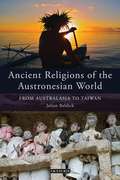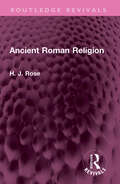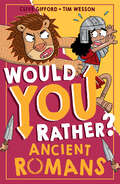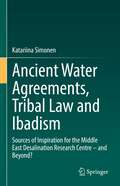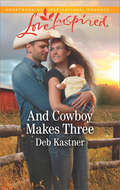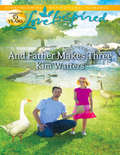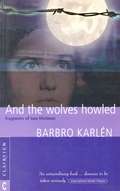- Table View
- List View
Ancient Religions: A Guide (Harvard University Press Reference Library)
by Sarah Iles JohnstonReligious beliefs and practices, which permeated all aspects of life in antiquity, traveled well-worn routes throughout the Mediterranean: itinerant charismatic practitioners journeying from place to place peddled their skills as healers, purifiers, cursers, and initiators; and vessels decorated with illustrations of myths traveled with them. New gods encountered in foreign lands by merchants and conquerors were sometimes taken home to be adapted and adopted. This collection of essays by a distinguished international group of scholars, drawn from the groundbreaking reference work Religions of the Ancient World, offers an expansive, comparative perspective on this complex spiritual world.
Ancient Religions, Modern Politics: The Islamic Case in Comparative Perspective
by Michael CookWhy does Islam play a larger role in contemporary politics than other religions? Is there something about the Islamic heritage that makes Muslims more likely than adherents of other faiths to invoke it in their political life? If so, what is it? Ancient Religions, Modern Politics seeks to answer these questions by examining the roles of Islam, Hinduism, and Christianity in modern political life, placing special emphasis on the relevance—or irrelevance—of their heritages to today's social and political concerns.Michael Cook takes an in-depth, comparative look at political identity, social values, attitudes to warfare, views about the role of religion in various cultural domains, and conceptions of the polity. In all these fields he finds that the Islamic heritage offers richer resources for those engaged in current politics than either the Hindu or the Christian heritages. He uses this finding to explain the fact that, despite the existence of Hindu and Christian counterparts to some aspects of Islamism, the phenomenon as a whole is unique in the world today. The book also shows that fundamentalism—in the sense of a determination to return to the original sources of the religion—is politically more adaptive for Muslims than it is for Hindus or Christians.A sweeping comparative analysis by one of the world's leading scholars of premodern Islam, Ancient Religions, Modern Politics sheds important light on the relationship between the foundational texts of these three great religious traditions and the politics of their followers today.
Ancient Religions, Modern Politics: The Islamic Case in Comparative Perspective (PDF)
by Michael CookWhy does Islam play a larger role in contemporary politics than other religions? Is there something about the Islamic heritage that makes Muslims more likely than adherents of other faiths to invoke it in their political life? If so, what is it? Ancient Religions, Modern Politics seeks to answer these questions by examining the roles of Islam, Hinduism, and Christianity in modern political life, placing special emphasis on the relevance—or irrelevance—of their heritages to today's social and political concerns.Michael Cook takes an in-depth, comparative look at political identity, social values, attitudes to warfare, views about the role of religion in various cultural domains, and conceptions of the polity. In all these fields he finds that the Islamic heritage offers richer resources for those engaged in current politics than either the Hindu or the Christian heritages. He uses this finding to explain the fact that, despite the existence of Hindu and Christian counterparts to some aspects of Islamism, the phenomenon as a whole is unique in the world today. The book also shows that fundamentalism—in the sense of a determination to return to the original sources of the religion—is politically more adaptive for Muslims than it is for Hindus or Christians.A sweeping comparative analysis by one of the world's leading scholars of premodern Islam, Ancient Religions, Modern Politics sheds important light on the relationship between the foundational texts of these three great religious traditions and the politics of their followers today.
Ancient Religions of the Austronesian World: From Australasia to Taiwan (International Library of Ethnicity, Identity and Culture)
by Julian BaldickAustronesia is the vast oceanic region which stretches from Madagascar to Taiwan to New Zealand. Encompassing both scattered archipelagos and major landmasses, Austronesia – derived from the Latin australis, 'southern', and Greek nesos, 'island' – is used primarily as a linguistic term, designating a family of languages spoken by peoples with a shared heritage. Julian Baldick, a celebrated historian of ancient religion, here argues that the diverse inhabitants of the Philippines, Taiwan, Indonesia, New Guinea and Oceania show a common inheritance that extends beyond language. This commonality is found above all in mythology and ritual, which reach back to an ancient, prehistoric past. From around 1250 BCE the original proto-Oceanic speakers migrated eastwards from southeast Asia. Navigating by the sun, the stars, bird flight, the swells of the sea and cloud-swathed mountain islands, Austronesian voyagers used canoes and outriggers to settle on new territories. They developed a unified pattern of religion characterised by mortuary rites, headhunting and agrarian rituals of the annual calendar, culminating in a post-harvest festival often sexual in nature. This unique overview of Austronesian belief and tradition will be essential reading for students of religion, prehistory and anthropology.
Ancient Roman Religion (Routledge Revivals)
by H. J. RoseFirst published in 1949, Ancient Roman Religion is an introduction to some of the most outstanding features of the complicated religion, or rather series of religions, which flourished in Rome between the earliest recoverable ages of her long history and the close of the classical epoch. This book will be of interest students of religion, literature and history.
Ancient Roman Religion (Routledge Revivals)
by H. J. RoseFirst published in 1949, Ancient Roman Religion is an introduction to some of the most outstanding features of the complicated religion, or rather series of religions, which flourished in Rome between the earliest recoverable ages of her long history and the close of the classical epoch. This book will be of interest students of religion, literature and history.
Ancient Romans (Would You Rather? #3)
by Clive GiffordWould you rather row a Roman vessel or be a chariot racer? Eat stuffed dormice or parrot heads? Only you can decide!
Ancient Supplication
by Fred NaidenThis is the first book-length treatment of supplication, an important social practice in ancient Mediterranean civilizations. Despite the importance of supplication, it has received little attention, and no previous study has explored so many aspects of the practice. Naiden investigates the varied gestures made by the supplicants, the types of requests they make, the arguments used in defense of their requests, and the role of the supplicandus, who evaluates and decides whether to fulfill the requests. Varied and abundant sources invite comparison between the societies of Greece and Rome and also among literary genres. Additionally, Naiden formulates an analysis of the ritual in its legal and political contexts. In constructing this rich and thorough study, Naiden considered over 800 acts of supplication from Greek, Hebrew, and Roman literature, art, and scientific sources. 30 illustrations and a map of the relevant locations accompany the text.
Ancient Supplication
by Fred NaidenThis is the first book-length treatment of supplication, an important social practice in ancient Mediterranean civilizations. Despite the importance of supplication, it has received little attention, and no previous study has explored so many aspects of the practice. Naiden investigates the varied gestures made by the supplicants, the types of requests they make, the arguments used in defense of their requests, and the role of the supplicandus, who evaluates and decides whether to fulfill the requests. Varied and abundant sources invite comparison between the societies of Greece and Rome and also among literary genres. Additionally, Naiden formulates an analysis of the ritual in its legal and political contexts. In constructing this rich and thorough study, Naiden considered over 800 acts of supplication from Greek, Hebrew, and Roman literature, art, and scientific sources. 30 illustrations and a map of the relevant locations accompany the text.
Ancient Synagogues in Palestine: A Re-evaluation Nearly a Century After Sukenik's Schweich Lectures (Schweich Lectures on Biblical Archaeology #2022)
by Jodi MagnessDozens of ancient synagogues have been discovered around the Mediterranean, most of which date to the fourth-sixth centuries CE and are concentrated in Palestine. In the 1930 Schweich Lectures, Eleazar Lipa Sukenik established a typology and chronology for these buildings. Ancient Synagogues in Palestine evaluates Sukenik's conclusions in light of new discoveries since his time. It opens with an overview of ancient synagogues in the region, followed by a survey of the historiography of the study of these buildings, highlighting its ideological roots in the early Zionist movement. In the final chapters, Magness examines the evidence for the dating of the synagogues at Khirbet Wadi Hamam and Capernaum, arguing that different synagogue types overlapped and were contemporary to the fourth-sixth centuries CE instead of being sequential, as Sukenik thought. This conclusion contradicts a widely accepted view that late antique Jewish communities in Palestine suffered and declined under supposedly oppressive Christian rule.
An Ancient Theory of Religion: Euhemerism from Antiquity to the Present (Routledge Monographs in Classical Studies)
by Nickolas RoubekasAn Ancient Theory of Religion examines a theory of religion put forward by Euhemerus of Messene (late 4th—early 3rd century BCE) in his lost work Sacred Inscription, and shows not only how and why euhemerism came about but also how it was— and still is—used. By studying the utilization of the theory in different periods—from the Graeco-Roman world to Late Antiquity, and from the Renaissance to the twenty-first century—this book explores the reception of the theory in diverse literary works. In so doing, it also unpacks the different adoptions and misrepresentations of Euhemerus’s work according to the diverse agendas of the authors and scholars who have employed his theory. In the process, certain questions are raised: What did Euhemerus actually claim? How has his theory of the origins of belief in gods been used? How can modern scholarship approach and interpret his take on religion? When referring to ‘euhemerism,’ whose version are we employing? An Ancient Theory of Religion assumes no prior knowledge of euhemerism and will be of interest to scholars working in classical reception, religious studies, and early Christian studies.
An Ancient Theory of Religion: Euhemerism from Antiquity to the Present (Routledge Monographs in Classical Studies)
by Nickolas RoubekasAn Ancient Theory of Religion examines a theory of religion put forward by Euhemerus of Messene (late 4th—early 3rd century BCE) in his lost work Sacred Inscription, and shows not only how and why euhemerism came about but also how it was— and still is—used. By studying the utilization of the theory in different periods—from the Graeco-Roman world to Late Antiquity, and from the Renaissance to the twenty-first century—this book explores the reception of the theory in diverse literary works. In so doing, it also unpacks the different adoptions and misrepresentations of Euhemerus’s work according to the diverse agendas of the authors and scholars who have employed his theory. In the process, certain questions are raised: What did Euhemerus actually claim? How has his theory of the origins of belief in gods been used? How can modern scholarship approach and interpret his take on religion? When referring to ‘euhemerism,’ whose version are we employing? An Ancient Theory of Religion assumes no prior knowledge of euhemerism and will be of interest to scholars working in classical reception, religious studies, and early Christian studies.
Ancient Water Agreements, Tribal Law and Ibadism: Sources of Inspiration for the Middle East Desalination Research Centre – and Beyond?
by Katariina SimonenThis book traces the development of Oman's inclusive agreements and highlights their importance for international negotiations, dealing with issues most relevant to humanity's own survival today, nuclear weapons or climate change.In Oman, a historical seafaring nation on the south-eastern corner of the Arabian Peninsula, a culture of agreement that accommodates the interests of everyone has developed around the division of scarce water resources.Life in the arid inland of the Omani Hajar mountains would not have been possible without water. Irrigation channel (falaj) construction is extremely old and skilful therein. Local practices evolved around the division of water and land on the basis of fairness. The community would be best served by inclusion and the avoidance of conflict.A specific Islamic school called Ibadi arrived at Oman early on in the eighth century. Ibadi scholars conserved local practices. Consultation and mediation by sheikhs and the religious leader, Imam, became the law of the land. The Omanis were known as the People of Consultation, Ahl Al Shura. In time, the practice of inclusive agreements would extend far beyond the village level, affecting Oman´s foreign policy under Sultan Qaboos. Oman´s water diplomacy succeeded in uniting the contestants of the Middle East Peace Process in the 1990s to work together on common problems of water desalination.
And Cowboy Makes Three (Cowboy Country #7)
by Deb KastnerShe fled their wedding years ago Now she’s back…with a baby!
And Father Makes Three (Mills And Boon Love Inspired Ser.)
by Kim Watters“YOUR DAUGHTER NEEDS YOU.” She’s saved countless lives, yet there’s one person emergency room doctor Elizabeth Randall can’t rescue—her adopted daughter, Jordan. Perhaps meeting her biological father, Blake Crawford, will be the lifeline Jordan needs. The handsome, guarded firefighter takes risks every day.
And God Knows the Martyrs: Martyrdom and Violence in Jihadi-Salafism
by Nathan S. FrenchNarratives of Jihadi-Salafi operations are often filled with praise for what are considered exemplary acts of self-renunciation in the vein of early Islamic tradition. While many studies sift through the biographies of these so-called martyrs for evidence of social, psychological, political, or economic strain in an effort to rationalize what are often labeled "suicide bombings," Nathan French argues that, through their legal arguments, Jihadi-Salafis craft a theodicy that is meant to address the suffering and oppression of the global Muslim community. Pulling from a broad selection of primary sources, including previously untranslated fatwas, on the subjects of martyrdom operations, jurisprudence, and political philosophies, French reveals that the Jihadi-Salafi legal debates on martyrdom reorient the basic objectives of the Shari 'a, focusing on maximizing the general welfare and promoting religion above all other concerns--including the preservation of life. Understanding this utilitarian turn opens the possibility for formulating a meaningful engagement and critique of Jihadi-Salafi legal interpretation and theories of warfare within a broader, just-war framework. And, as the jurists and propagandists of ISIS have demonstrated, this turn also opens the possibility for the use of self-renunciative violence as a means of state formation.
And God Knows the Martyrs: Martyrdom and Violence in Jihadi-Salafism
by Nathan S. FrenchNarratives of Jihadi-Salafi operations are often filled with praise for what are considered exemplary acts of self-renunciation in the vein of early Islamic tradition. While many studies sift through the biographies of these so-called martyrs for evidence of social, psychological, political, or economic strain in an effort to rationalize what are often labeled "suicide bombings," Nathan French argues that, through their legal arguments, Jihadi-Salafis craft a theodicy that is meant to address the suffering and oppression of the global Muslim community. Pulling from a broad selection of primary sources, including previously untranslated fatwas, on the subjects of martyrdom operations, jurisprudence, and political philosophies, French reveals that the Jihadi-Salafi legal debates on martyrdom reorient the basic objectives of the Shari 'a, focusing on maximizing the general welfare and promoting religion above all other concerns--including the preservation of life. Understanding this utilitarian turn opens the possibility for formulating a meaningful engagement and critique of Jihadi-Salafi legal interpretation and theories of warfare within a broader, just-war framework. And, as the jurists and propagandists of ISIS have demonstrated, this turn also opens the possibility for the use of self-renunciative violence as a means of state formation.
'And He Will Take Your Daughters...': Woman Story and the Ethical Evaluation of Monarchy in the David Narrative (The Library of Hebrew Bible/Old Testament Studies)
by April D. WestbrookApril Westbrook explores the intentional inclusion of woman stories (those displaying significant female presence) within the David narrative in the books of Samuel. These stories are made prominent by the surprisingly high number of their occurrences as well as the sequentially progressive literary pattern in which they occur in the larger narrative. Westbrook shows that the dramatic and detailed accounts within the story repeatedly challenge the reader to consider the experiences of women and their contribution to the purpose of the larger narrative. When viewed collectively, these woman stories serve to stir the reader's responses in ways which systematically call into question the nature of the monarchy itself as a power system-both its impact upon the nation and upon the kings who rule. Although King David is often held up as a paragon of virtue, the experiences of the women in his life frequently reveal a different side of his character, and the reader must wrestle with the resultant ambiguity. In the process, the reader must also think deeply about the inevitably negative aspects of hierarchical social structures and why this biblical text is apparently designed to press the reader toward unavoidable and uncomfortable personal confrontation with these realities concerning the use of power within community life.
'And He Will Take Your Daughters...': Woman Story and the Ethical Evaluation of Monarchy in the David Narrative (The Library of Hebrew Bible/Old Testament Studies)
by April D. WestbrookApril Westbrook explores the intentional inclusion of woman stories (those displaying significant female presence) within the David narrative in the books of Samuel. These stories are made prominent by the surprisingly high number of their occurrences as well as the sequentially progressive literary pattern in which they occur in the larger narrative. Westbrook shows that the dramatic and detailed accounts within the story repeatedly challenge the reader to consider the experiences of women and their contribution to the purpose of the larger narrative. When viewed collectively, these woman stories serve to stir the reader's responses in ways which systematically call into question the nature of the monarchy itself as a power system-both its impact upon the nation and upon the kings who rule. Although King David is often held up as a paragon of virtue, the experiences of the women in his life frequently reveal a different side of his character, and the reader must wrestle with the resultant ambiguity. In the process, the reader must also think deeply about the inevitably negative aspects of hierarchical social structures and why this biblical text is apparently designed to press the reader toward unavoidable and uncomfortable personal confrontation with these realities concerning the use of power within community life.
“And in Length of Days Understanding”: Essays on Archaeology in the Eastern Mediterranean and Beyond in Honor of Thomas E. Levy (Interdisciplinary Contributions to Archaeology)
by Erez Ben-Yosef Ian W. N. JonesThis two-volume book presents cutting-edge archaeological research, primarily as practiced in the Eastern Mediterranean region. These volumes’ key foci are inspired by the work of Thomas E. Levy. Volume 1 provides an in-depth look at new archaeological research in the southern Levant (primarily in modern Israel and Jordan) inspired by Levy’s commitment to understanding social, political, and economic processes in a long-term or “deep time” perspective. Volume 2 focuses on new research in several key areas of 21st century anthropological archaeology and archaeological science. Volume 1 is organized around two major themes: 1) the later prehistory of the southern Levant, or the Neolithic, Chalcolithic, and Bronze Age, and 2) new research in biblical archaeology, or the historical archaeology of the Iron Age. Each section contains a combination of new perspectives on key debates and studies introducing new research questions and directions. Volume 2 is organized aroundfive major themes: 1) the archaeology of the Faynan copper ore district of southern Jordan, a key region for archaeometallurgical research in West Asia where Levy conducted field research for over a decade, 2) new research in archaeometallurgy beyond the Faynan region, 3) marine and maritime archaeology, focusing on issues of trade and environmental change, 4) cyber-archaeology, an important 21st century field Levy conceived as “the marriage of archaeology, engineering, computer science, and the natural sciences,” and 5) key issues in anthropological archaeological theory. In addition to presenting the reader with an up-to-date view of research in each of these areas, the volume also has chapters exploring the connections between these themes, e.g. the maritime trade of metals and cyber-/digital archaeological approaches to metallurgy. The work contains contributions from both up-and-coming early career researchers and key established figures in their fields. This book is an essential reference for archaeologists and scholars in related disciplines working in the southern Levant and the Eastern Mediterranean.
And It Was Morning: The Story of the Jews in our Time (Routledge Revivals)
by Poul BorchseniusOriginally published in 1962, the title of this book is taken from Genesis and is an allusion to the establishment of a Jewish National State as the successful termination of long centuries of exile. The Eastern ‘day’ begins at nightfall; and after a prolonged period of darkness, culminating in the horrors of Hitler’s regime, the Jews face a new era. The author describes the rise of antisemitism in Germany, the deportations and final solution and the persecutions in Russia and other eastern European countries. And, after the night, the day: the slow growth of the Zionist idea, the eventual establishment of the State of Israel and the birth pangs of the new State in its wars with the neighbouring Arabs. The book contains many graphic portraits of leading personalities, such as David Ben-Gurion, Gold Meir and Nasser.
And It Was Morning: The Story of the Jews in our Time (Routledge Revivals)
by Poul BorchseniusOriginally published in 1962, the title of this book is taken from Genesis and is an allusion to the establishment of a Jewish National State as the successful termination of long centuries of exile. The Eastern ‘day’ begins at nightfall; and after a prolonged period of darkness, culminating in the horrors of Hitler’s regime, the Jews face a new era. The author describes the rise of antisemitism in Germany, the deportations and final solution and the persecutions in Russia and other eastern European countries. And, after the night, the day: the slow growth of the Zionist idea, the eventual establishment of the State of Israel and the birth pangs of the new State in its wars with the neighbouring Arabs. The book contains many graphic portraits of leading personalities, such as David Ben-Gurion, Gold Meir and Nasser.
And Man Created God: Kings, Cults and Conquests at the Time of Jesus
by Selina O'GradyAnd Man Created God is a sweeping exploration of the changing religions of the empires and peoples of the world at the time of Jesus: a work of extraordinary richness and ambition, this is popular history at its best.At the time of Jesus's birth, the world was in ferment. Across Europe, North Africa, the Middle East and Asia - societies rife with gods and messiahs, priests and warriors - the old certainties of family, village and tribe were being overturned. Religion was becoming the source of order and stability.And Man Created God takes the reader on a dazzling journey across the empires of the ancient world to reveal how emperors and kings manipulated religion to consolidate their power. In Rome, Augustus was deified by his brilliant spin doctors; in what is now Sudan, the warrior queen Amanirenas exploited her godlike status to inspire her armies to face, and defeat, Rome; while in China, the usurper Wang Mang won and lost the throne over his obsession with Confucianism.In this riveting account of the interplay of faith and power, Selina O'Grady answers the most urgent question of all: how did the tiny Jesus cult triumph over more popular religions - the goddess Isis, the miracle worker Apollonius, even the cult of Augustus - to become the world's dominant faith?
And the Mirror Cracked: Feminist Cinema and Film Theory
by A. SmelikAnd The Mirror Cracked explores the politics and pleasures of contemporary feminist cinema. Tracing the highly productive ways in which feminist directors create alternative film forms, Anneke Smelik highlights cinematic issues which are central to feminist films: authorship, point of view, metaphor, montage and the excessive image. In a continuous mirror game between theory and cinema, this study explains how these cinematic techniques are used to represent female subjectivity positively and affirmatively. Among the films considered are A Question of Silence , Bagdad Cafe , Sweetie and The Virgin Machine .
And the Wolves Howled: Fragments of two lifetimes
by Barbro Karlen"An extraordinary book... deserves to be taken seriously." – International Herald Tribune."A very thought provoking read! Whether or not she was really Anne Frank in another life, I do not doubt Karlén's sincerity." – Rabbi Yonassan Gershom, author of Beyond the Ashes and From Ashes to Healing.For as long as she can remember, Barbro Karlén has harboured terrible memories of a previous existence on earth as the Jewish girl Anne Frank, author of the famous Diary. Until recently, she had kept this knowledge private. Now, prompted by a series of events which culminated in a struggle for her survival, she is ready to tell her amazing story.And the Wolves Howled is the autobiography of Barbro Karlén, from her early fame as a bestselling child literary sensation in her native Sweden, to her years as a policewoman and a successful dressage rider. But this is no ordinary life history. As the victim of discrimination, personal vendettas, media assassination, libel and attempted murder, Karlén is forced to fight for her very being. In the dramatic conclusion to her living nightmare, she is shown the karmic background to these events. She glimpses fragments of her former life, and begins to understand how forces of destiny reach over from the past into the present. With this knowledge she is finally free to be herself...And the Wolves Howled is the story of one woman's superhuman struggle for truth in the face of discrimination and lies.


